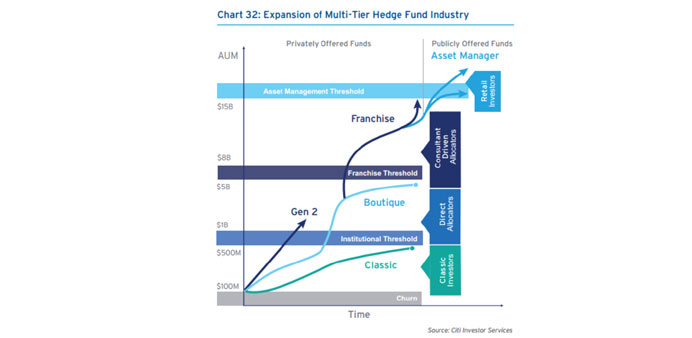Bloomberg/New York
Hedge funds are betting the stock- market tranquility that’s stifling trading and hurting bank profits will be around for a while.
Large speculators have added bets on lower volatility and were net short almost 82,000 contracts on VIX futures last month, the most since October, according to data from the Commodity Futures Trading Commission. The strategy will be profitable should the Chicago Board Options Exchange Volatility Index continue its 15% retreat this year.
The flood of economic stimulus from global central banks is helping diminish stock-price swings, encouraging investors to trade less and pushing the VIX within three points of an all- time low. Stocks rallied and the volatility gauge fell yesterday after the European Central Bank became the first major central bank to take one of its main rates negative.
“Volatility can go even lower than it already is,” Max Breier, a senior equity-derivatives trader at BMO Capital Markets Corp in New York, said by phone. “The Fed is still buying assets and there’s still a lot of money sloshing around the system and the rest of the world is now in an easing cycle.”
A measure of fluctuations on the MSCI All-Country World Index, which tracks stocks in both developed and emerging markets, dropped to 4.77 on Thursday, the lowest level since 1996, according to 30-day historical data compiled by Bloomberg. The Standard & Poor’s 500 Index hasn’t closed up more than 1% for 34 days, the longest stretch since December 2006.
The ECB cut its deposit rate to minus 0.1% and, in a bid to get credit flowing, also opened a €400bn ($546bn) liquidity channel tied to bank lending. Officials will start work on an asset-purchase plan. While the Federal Reserve has reduced stimulus, it’s still buying $45bn of bonds a month to lower borrowing costs.
Short selling on the VIX, which amounts to speculation that equities will rise, has increased since March as investors began to regain confidence after a stock selloff earlier in the year. They were net short 81,779 futures on the gauge, compared with a mean of 56,000 since in the beginning of 2012, data from a Commitment of Traders report by the Washington-based CFTC show.
“If you look out at the short term, there don’t seem to be many events that are going to upset the market,” Joe “JJ” Kinahan, chief strategist at TD Ameritrade Holding Corp, said in a phone interview from Chicago. His firm has $617bn in client assets. “We’re getting an all-time high at slower volume.”
About 1.8bn shares traded each day in S&P 500 companies last month, the fewest since 2008, according to data compiled by Bloomberg. At an investor conference in May, Goldman Sachs Group Inc President Gary Cohn blamed the reduction in trading on calm markets and the Fed’s efforts to hold down interest rates.
Citigroup Chief Financial Officer John Gerspach said last month that second-quarter trading revenue could fall as much as 25% from year-earlier levels, and JPMorgan Chase & Co estimated a 20% drop. Less economic stimulus from the Fed and a potential slowdown in emerging markets may lead to choppy stock-market trading, according to Stuart Freeman and Scott Wren, equity strategists at Wells Fargo Advisors. The S&P 500 hasn’t fallen more than 10% since mid-2012. The “road ahead may be rocky,” they wrote in a report dated June 3. “Stock investors may hear a word during the coming months that hasn’t been uttered much lately: volatility.”
The VIX will probably revert back it long-term average, Jim Strugger, a derivatives strategist at MKM Partners LLC, wrote in a research report dated June 4. Investors can use a strategy known as a call spread to profit on the likelihood of higher volatility, he said. Strugger recommends buying June 14 calls on the VIX and offsetting the cost by selling October 28 calls.
Stock-market swings are going to remain suppressed as central banks worldwide introduce new ways to spur economic growth, even as the US pulls back on asset purchases, Breier of BMO said. Japanese Prime Minister Shinzo Abe’s administration is set to unveil the second phase of its growth strategy this month and investors are seeking lower corporate taxes and labor market flexibility.
“The market is underestimating the downside potential for volatility here,” Breier said. “We’re not going to see a jump- type event to the downside. It’s going to be a grind.”



